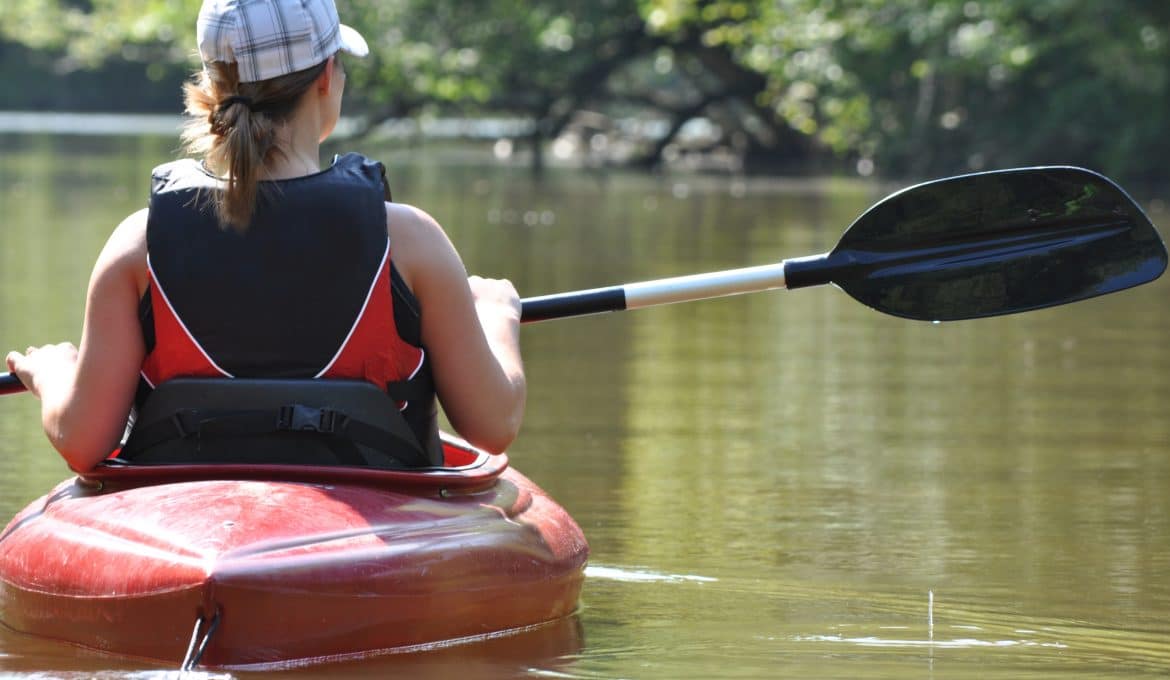I’m a compact kayaker standing at 5’1”. For the most part, all kayakers should consider the same factors when choosing the right kayak regardless of body shape and size. But there are a few things compact paddlers should give extra consideration to as they purchase a kayak.
Kayak Weight
Lighter kayaks are easier to transport to and from the water and load onto car carriers. If you are a paddler with shorter stature you will be far safer and more comfortable on the water if you are confident you can carry your kayak unaided for short distances. Of course, you will develop strength, endurance, and carrying techniques over time, but before you purchase a kayak be sure you are able to lift it by yourself.
Materials to consider
Plastic kayaks are generally heavier but more durable so they won’t be too damaged if they are dropped or dragged.
“Airlite” or “Duralite” materials are a quality mix of price, weight, and durability. Kayaks made from these materials are lighter than standard plastic kayaks and more durable than high-end fiberglass boats that damage easily. Even though they come with a slightly higher price point it might be a worthwhile investment for smaller paddlers.
Kayak Design
Almost all kayaks are designed to fit a broad range of body types but every body is different and not every kayak will easily size down to fit compact kayakers. You want to find a kayak that makes you feel comfortable and in full control of the boat. Focus on making sure your hips, butt, thighs, and feet are very comfortable and in good contact with the right parts of the kayak.
If you are considering a sit-in kayak, the width of the cockpit and the fit of the thigh braces should be comfortable and not too restrictive. Make sure you can get in and out of the cockpit easily and quickly.
Consider kayaks with adjustable seats designed to help relieve pressure points and improve blood flow to your legs. Some kayaks allow for after-market seat upgrades that dramatically improve overall comfort. Many paddlers of all sizes find seats with higher backs more comfortable as they provide better lumbar support.
Don’t be afraid to sit in a kayak on the showroom floor for a while to see how it feels. If there are pressure points just sitting for a few minutes they will only get worse after an hour of paddling.
Helpful Transportation Tools

Compact paddlers might need to be creative or invest in other tools for transporting their kayaks.
Kayak carts: Kayak carts (sometimes called dollies) are two wheels that strap onto one end of your kayak to make transporting to and from the water a cinch. They come in a variety of sizes, designs, and price points ranging from $40 to several hundred dollars.
Load Assist: Loading kayaks onto car top carriers is particularly difficult for smaller paddlers (and even tall paddlers with large cars). Kayak Load Assist bars easily attach to the roof rack and make it easy for one person to lift a kayak onto a roof rack.
There are also a number of kayak racks with integrated load assist features like retractable bars that allow you to load and unload your kayak at waist level at the side of the vehicle. These kayak carriers tend to come with a heftier price tag but are worth the investment for shorter paddlers to be able to transport their own kayak.
Kayak Accessories
Having the right kayak accessories can make all the difference for comfortable, safe paddling.
Paddles: Compact paddlers with shorter arms should usually opt for paddles with slightly longer shafts to compensate for the width of the kayak. Most paddle companies have easy size charts that compare your height and kayak width to recommend the right paddle size range.
PFDs for Women: Finding a lifejacket that fits your body type is important for safety and comfort. The majority of PFDs on the market are unisex. Only recently have PFD’s designed for women come on the market.
Women’s bodies are proportioned differently than men. If you are on the bustier end of the spectrum, a women’s lifejacket with contoured foam will probably be far more comfortable than a unisex PFD.
Unisex lifejackets also tend to be designed for longer torsos so petite paddlers will likely find them awkward and potentially uncomfortable. Simply tightening all the straps as far as possible is not necessarily the safest choice. Women’s PFDs err on the shorter side for more petite frames.
When selecting a PFD, pay attention to the adjustment points. Make sure the straps are around the right parts of your body and that you can dial in the right fit for safety and comfort.
While there are some women’s lifejackets that are more expensive, many women’s specific PFDs are priced similarly to unisex lifejackets of similar quality. However, this is not an area you want to skimp on. It’s better to pay a little more for a comfortable lifejacket you will wear than a cheap one you won’t wear.
Just like in most areas of life, with a little creativity, proper sizing, and perhaps a few extra tools, compact paddlers will be able to enjoy kayaking just as much as anyone else.
If you are a compact kayaker, do you have any creative workarounds or advice?




